Going out and coming back.
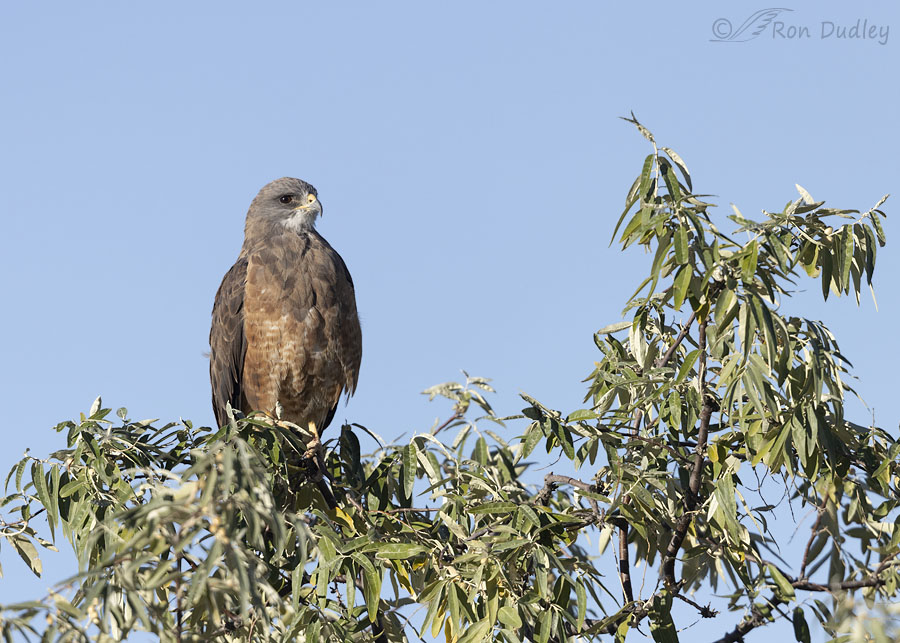
1/4000, f/6.3, ISO 800, Canon R5, Canon EF500mm f/4L IS II USM + 1.4 tc, not baited, set up or called in
Two days ago I found this intermediate morph Swainson’s Hawk hunting from atop this olive tree. Based on his behavior it was obvious that ‘he’ was actively hunting so I waited for takeoff and hoped against hope to get photos of him with prey. That didn’t happen but I did get takeoff and flight shots of him going both ways and photos of him on the ground, sans prey..
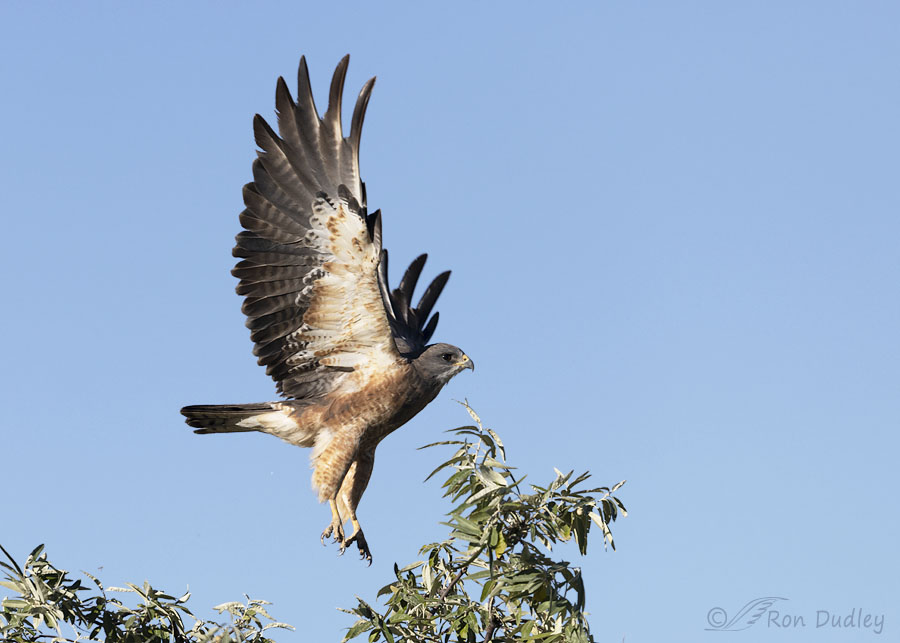
1/4000, f/6.3, ISO 320, Canon R5, Canon EF500mm f/4L IS II USM + 1.4 tc, not baited, set up or called in
It took six minutes for him to spot potential prey in the freshly mowed hayfield across the road and on my right. He had to avoid the tree branch directly in front of him, which slowed his takeoff as he gained elevation before proceeding, so I got several photos similar to this one. Very soon after this shot was taken my pickup’s windshield prevented me from getting any more flight shots.
But I saw where he landed in the hayfield on my right, so I drove forward and turned around in hopes that he’d still be there when I got into position again.
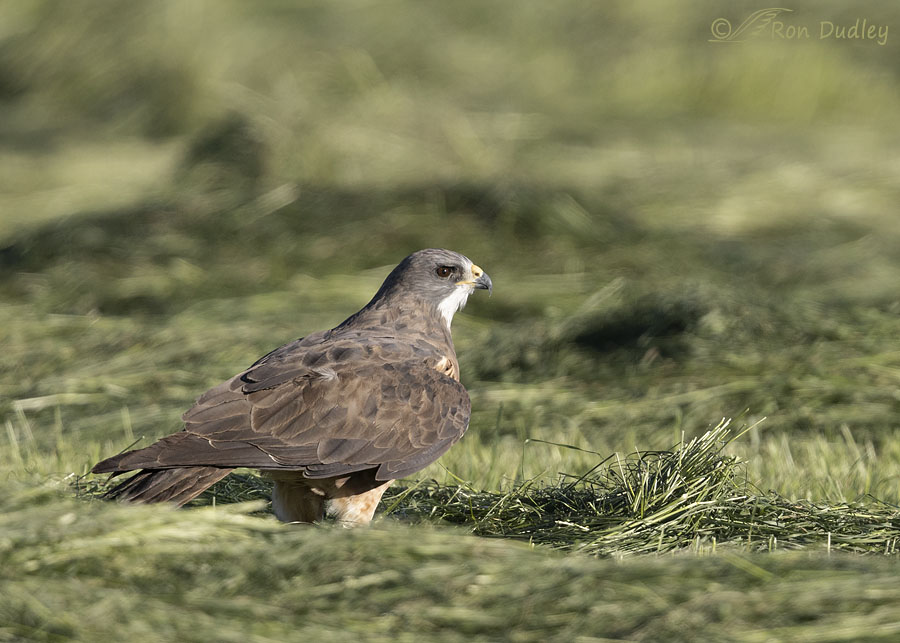
1/3200, f/6.3, ISO 640, Canon R5, Canon EF500mm f/4L IS II USM + 1.4 tc, not baited, set up or called in
He was. I suspect he’d been after a grasshopper (although a vole is another possibility) but if he caught anything he’d already snarfed it down before I got into position.
I strongly suspected that he’d return to the same tree for some more hunting so I waited for takeoff again. It was a long wait, which tried my patience, but eventually…
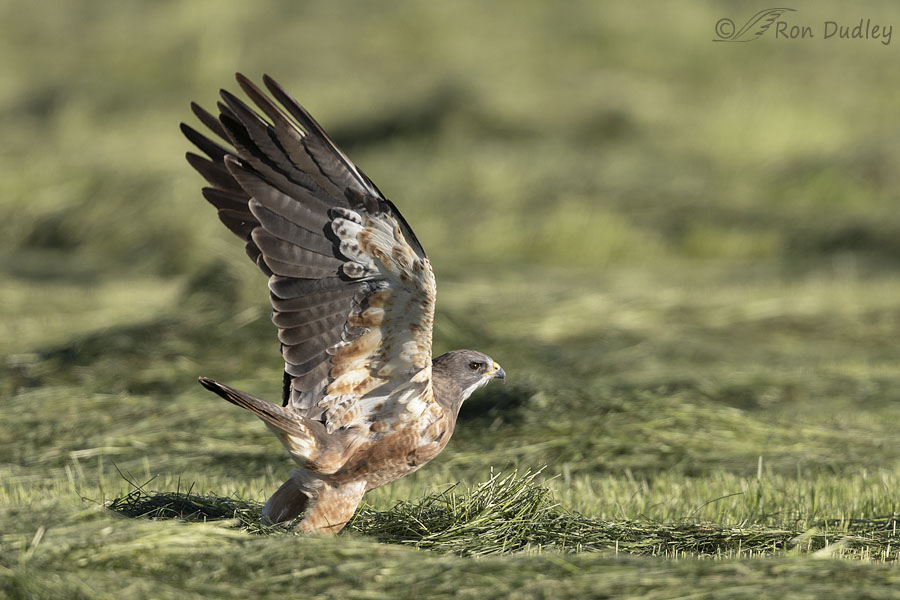
1/3200, f/6.3, ISO 640, Canon R5, Canon EF500mm f/4L IS II USM + 1.4 tc, not baited, set up or called in
he took off again, initially to my right.
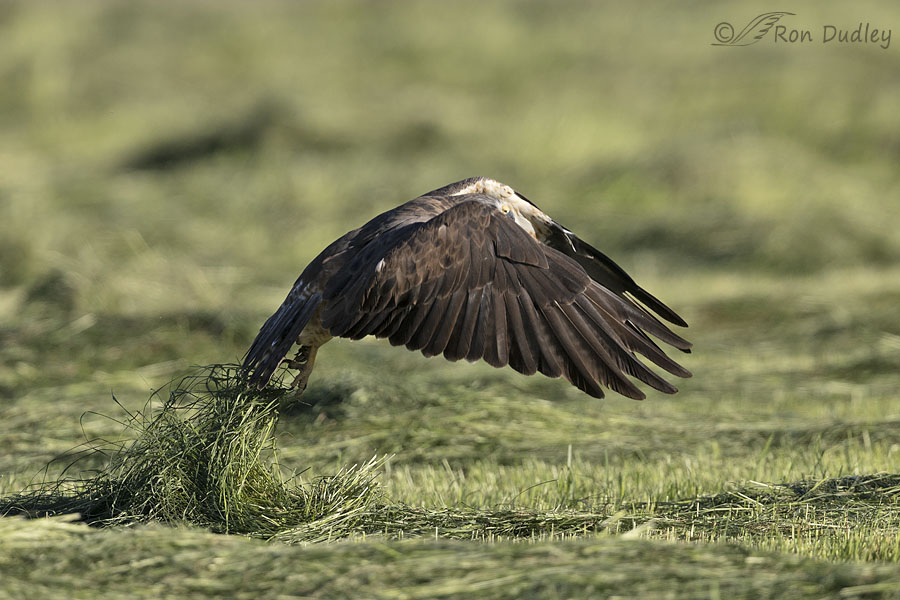
1/3200, f/6.3, ISO 640, Canon R5, Canon EF500mm f/4L IS II USM + 1.4 tc, not baited, set up or called in
In this photo we can’t see most of his head, or his eye, but I’m including it to document the large pile of cut hay that his talons brought up when he took off.
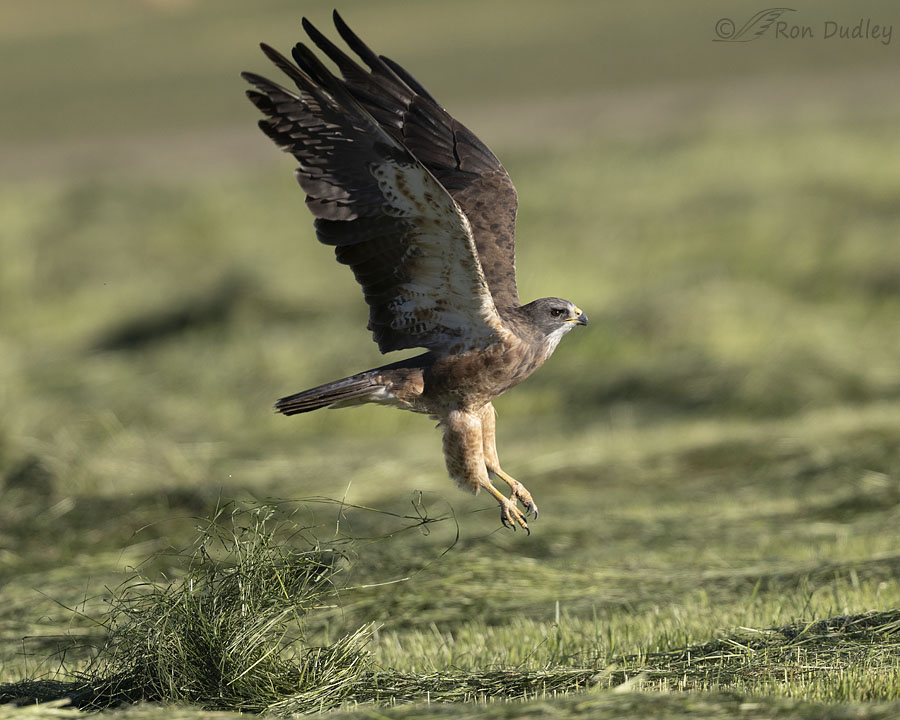
1/3200, f/6.3, ISO 640, Canon R5, Canon EF500mm f/4L IS II USM + 1.4 tc, not baited, set up or called in
In the next shot most of the clump of hay had reached its apex and was beginning to fall back to the ground but…
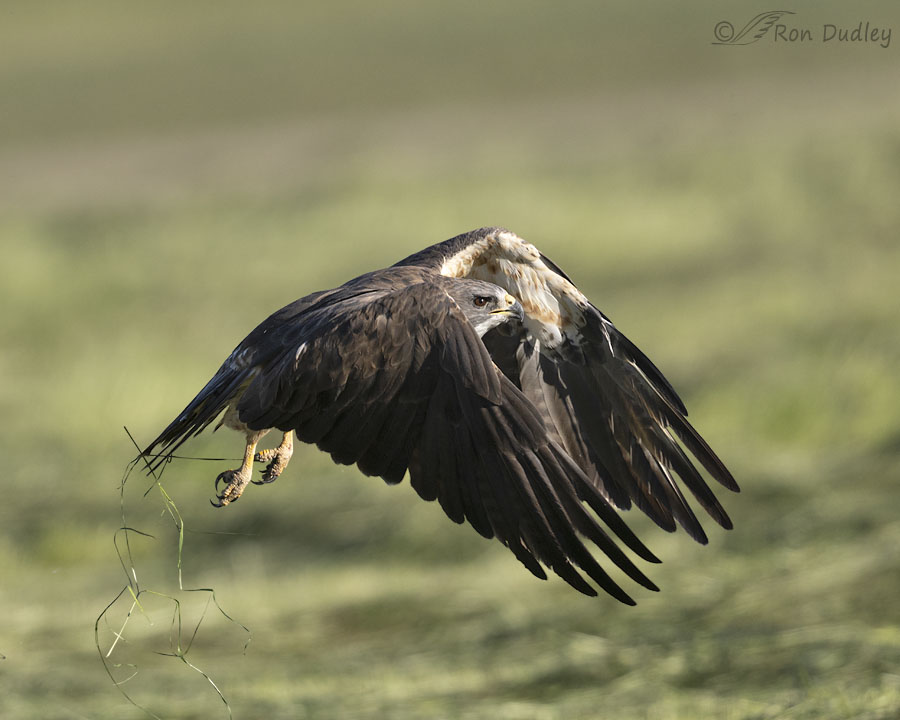
1/3200, f/6.3, ISO 640, Canon R5, Canon EF500mm f/4L IS II USM + 1.4 tc, not baited, set up or called in
some of it remained stuck to his talons.
At this point he began a long, sweeping turn to his right in order to…
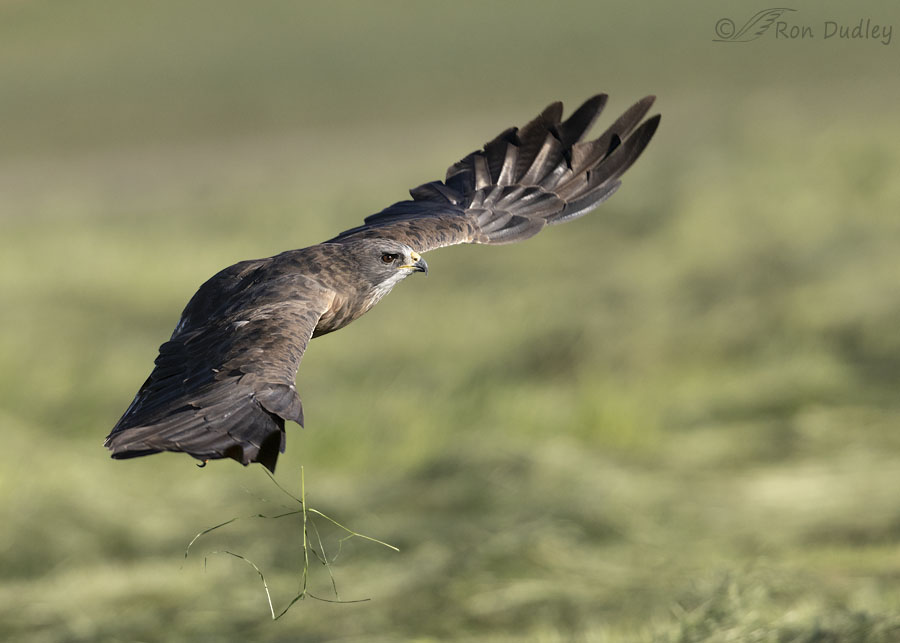
1/3200, f/6.3, ISO 640, Canon R5, Canon EF500mm f/4L IS II USM + 1.4 tc, not baited, set up or called in
return to his previous hunting perch, which meant that he’d have to fly right over the top of my pickup.
I got many more photos of him as he was coming my way but because of the side light and his continuing turn, this is the last shot I got for a long time that had any light on his face.
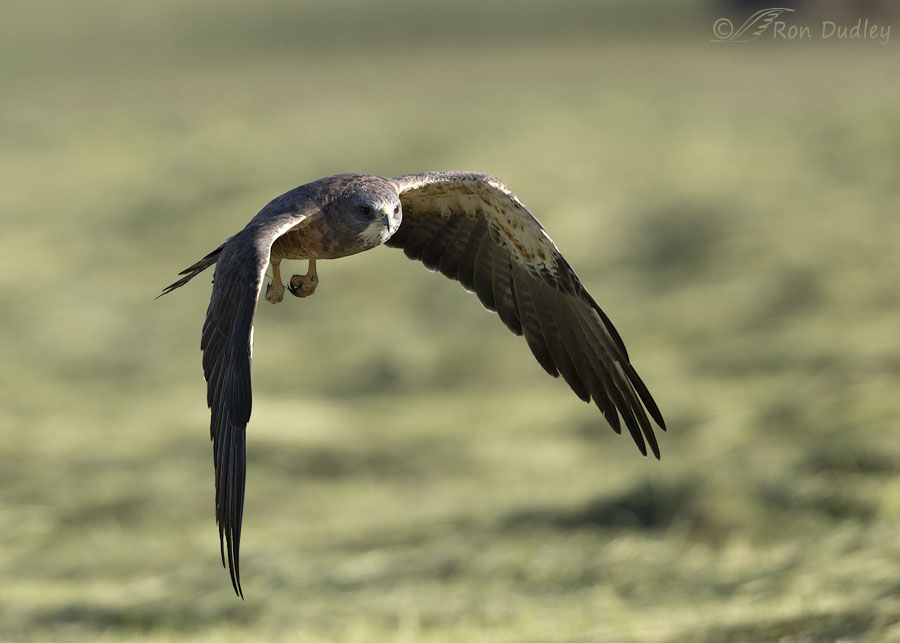
1/3200, f/6.3, ISO 640, Canon R5, Canon EF500mm f/4L IS II USM + 1.4 tc, not baited, set up or called in
Finally, 18 shots later, he’d turned far enough to his right to put a catch light in his left eye. This isn’t my favorite photo of him, but it shows that by this time nearly all of the hay had fallen off of his closed talons.
As expected, he returned to the same hunting perch so I could have turned my pickup around a second time and attempted to photograph a similar process all over again, but I chose to drive down the road and look for other birds.
Which was probably a mistake because these were the last decent shots I got all morning.
Ron


How did I miss this this morning? Never mind, it gave me a treat after a long day volunteering. Thank you. And the beauteous hawk.
Swsinson’s are hard for me to identify. What is the tell for you?
Arwen, it partially depends on which of the three color morphs they are. But one thing I look for is wing length relative to tail length. When their wings are folded they’re as long or longer than their tail.
Good tip for me for identification!
Thank you! I’m tucking that away in my memory banks.
Ooh, a Swainson’s and a sea of green, a gorgeous combination! I particularly like the third and fourth images because he looks like he’s wading in and then rising from that sea, his intent clearly etched on his face … and then aloft in #6 so we can see his fine wings and pantaloons! Great photos, Ron — I hope this Swainson’s fix will tide you over ‘til they (and you) return to the field!
Speaking of “returns”, welcome back Chris. And thank you.
Somehow from this series I really get a sense of the “substance” of his wings and body – the muscles and thickness, heft, solidity. With #8, I picture a 737 waiting at the airport.
The hay is beautiful – our local NPR radio station had a news report the other day on the difficulties hay farmers are having here in the northwest this year –
weather, shipping, cost. Our local hayfields are rapidly turning into huge housing developments, sigh.
Good wishes for your “big day”.
Carolyn, I think many areas in the west are having difficulties getting the hay they need. You may have noticed Judy’s comment below where she said in her area of MT they’re “haying the ditches” and they’re still not getting enough.
Wonderful series. Getting photos of prey could be tricky this time of year. After breeding the diet of adults is almost exclusively insects, especially grasshoppers and dragonflies. Many of these are caught in mid-flight and transferred from feet to beak in mid-air. I’ve read several accounts of them hunting communally while running along the ground. I’ve not seen this because we don’t have them west of the Cascades so I only have short encounter when I travel eastside. They certainly take many voles, ground squirrels, etc. durinig breeding season so it’s interesting that insects are almost the exclusive diet after breeding
Dan, In Montana I’ve watched them on the ground as they ran after grasshoppers. There were three of them, one adult and two juvies, so perhaps they were hunting communally. Like many raptors they run ‘funny’ so it’s hilarious to watch.
This series is incredible — colors, framing, sharpness, composition. Not to mention some of the best (if not the best) swainsons hawk photos I recall seeing. Thanks.
Thanks very much, Kent.
Great series, Ron… He sure got caught up in the clump of fresh cut hay! Having to maneuver the pickup for the shot could be a real pain BUT it worked out…… #’s 3 and 4 are the most appealing to me.
He sure got caught up in the clump of fresh cut hay! Having to maneuver the pickup for the shot could be a real pain BUT it worked out…… #’s 3 and 4 are the most appealing to me.
Hay is impressive as it’s been here bad enough they’re “haying the ditches” and baling a lot of straw even coming up short on that for what people want.
Judy, I was just lucky it was early in the morning and there was no traffic on the road. If there had been I wouldn’t have even attempted to turn around for the shots in the hayfield.
Love those take offs from the grass. Outstanding !!!!! I rarely see Swainsons here so this is a treat to see this very handsome one.
I cracked up at your use of “snarfed”. I have not heard that word or seen it in many many years. Merriam Webster says it originated about circa 1963. Maybe you were the one who originated it.
Everett, a good friend of mine on Facebook had never heard of the word “snarf”. It means “to eat or drink quickly” but apparently it has another meaning and he sent it to me. One I’d never heard of. Talk about perverted…
https://www.urbandictionary.com/define.php?term=snarf&page=2&fbclid=IwAR08-9M_MybRiRkD60A6kJ4g4xS_1lT5nzloQI7PParFF0rIf2jHCbsAC34
Wow – sure never heard of that nor have I ever seen someone doing that fortunately ……………
GEEZ! LMAO over that even if rather disgusting – never heard of that one!
– never heard of that one!
A photo essay on “hunting technique”– both YOURS and the hawk’s !
It’s fascinating to me to be able to read your thought and anticipation
process in bringing about a successful capture such as is this series.
I especially admired #6….it’s a classic! You’re right about the green–
given your customary hunting grounds, it’s unusual and refreshing…..
Kris, I was just lucky that the prey he spotted was in the hayfield. He was also hunting behind him, which was the more typical dry, brown habitat we have this time of year.
Very nice series! The hay stuck in the talon reminds me of a golf divot. 3rd shot is probably my fave – like his facial expression. Good to see you out and about.
It was good to be out and about, Kathleen – probably for the last time before the big day.
Wow. Hard to pick a favorite out of this series. Thanks for the closeup look at one of these (for me) seldom seen hawks.
Michael, they’ll be “seldom seen” for me very soon because they’ll be beginning to leave for South America any time now.
Very nice series Ron….love the narrative that goes along with your photos. Very sharp images !!
Thanks very much, Gary.
Lot’s of interesting features in these photos. I do like the third photo with feet sunk in the hay and the bright face and throat. Intermediate morph is a very photogenic look. And the last, looking like he’s dog paddling through the air.
Thanks, Lyle. I like all the green in many of these photos – for me, around here, green is often at a premium.
Glad you felt well enough to go out and get a good story. Nice shots.
Richard, being in the field with birds is rejuvenating.
What a great series. I especially enjoyed the photo showing him with the bunch of hay caught up by his talons — because of the wing position. I’ve caught that only once, as a White-faced Ibis was taking off; the almost triangular shape of the bird at that point is attention-grabbing.
Thank you, Shoreacres.